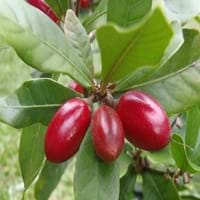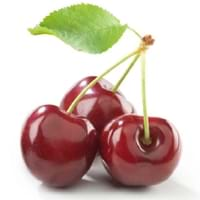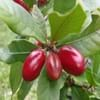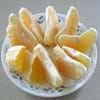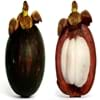Health Benefits
Good for diabetics, Improves well-being, Miraculin/miracle fruit makes sour things taste sweet
Arthritis prevention, Cancer prevention, Gout treatment, Heart care, Muscle pain relief, Regulation of heart rate, Treatment of alzheimer's disease
General Benefits
Has taste modifying effect
Anti oxidant properties, Anti-inflammatory properties, Controls blood pressure, Cures headache, Sore throat treatment
Skin Benefits
NA
Anti-aging benefits, Brightens and lightens complexion, Skin rejuvenation, Treatment of dark spots
Hair Benefits
NA
Acts as moisturizer, Protects hair, Regulates hair growth, Rejuvenates scalp
Allergy Symptoms
Itching, Skin rash
Anaphylaxis, Breathing difficulty, Fainting, Hives, Itching, Nasal congestion, Nausea, Swelling of mouth, tongue or lips, Tingling sensation in mouth, Vomiting, Wheezing
Side Effects
Changes taste of food eaten after this fruit, Coagulation
Abdominal cramps, Allergic reaction, Bloating, Intestinal gas
Best Time to Eat
As a snack in the late afternoon, Eat the fresh ones, avoid mixing with any other foods, don't eat after meal., Morning time (before lunch)
Best if taken as a breakfast (or empty stomach), As a snack in the late afternoon, Don't eat after meal, Morning time (before lunch)
Protein to Carb Ratio
Not Available
Vitamin A (Retinol)
Not Available
Vitamin B1 (Thiamin)
Not Available
Vitamin B2 (Riboflavin)
Not Available
Vitamin B3 (Niacin)
Not Available
Vitamin B5 (Pantothenic Acid)
Not Available
Vitamin B6 (Pyridoxin)
Not Available
Vitamin B9 (Folic acid)
Not Available
Vitamin C (Ascorbic Acid)
Vitamin K (Phyllochinone)
Not Available
Lutein+Zeaxanthin
Not Available
Phytosterol
Not Available
Water Content
Not Available
Calories in Fresh Fruit with Peel
Not Available
Calories in Fresh Fruit without Peel
Not Available
Not Available
Calories in Frozen Form
Not Available
Calories in Dried Form
Not Available
Calories in Canned Form
Not Available
Calories in Juice
Not Available
Calories in Jam
Not Available
Calories in Pie
Not Available
Varieties
Gymnema Sylvestre and Thaumatococcus Daniellii
Vandalay, Stella, Tehranivee, Sonata, Whitegold, Symphony, Blackgold, Sunburst, Lapins, Skeena and Sweetheart
Inside Color
Greyish-white
Red
Origin
West Africa
Europe, Western Asia
Soil Type
Well-drained
Sandy
Climatic Conditions
Rainfall
Cold
Facts about
- The name 'Miracle' because of the magical experience you get after eating it.
- When you have lemon after eating this fruit, it tastes sweet as if it is added with sugar.
- It is also used as natural sweetener.
- The word cherry is derived from the Turkish town of Cerasus.
- In Oliver, British Columbia, a pie of 39,683 pounds was baked which holds the record of biggest cherry pie.
- National cherry cheese cake day is on April 23.
Other Countries
NA
Austria, Chile, China, France, Germany, Greece, Iran, Italy, Poland, Romania, Russia, Serbia, Spain, Syria, Ukraine, United States of America, Uzbekistan
Top Importer
Not Available
Russia
Top Exporter
United States of America
Poland
Botanical Name
Synsepalum Dulcificum
Prunus avium
Synonym
Miracle Berry, Miraculous Berry and Sweet Berry
Not Available
Subkingdom
Tracheobionta
Tracheobionta
Division
NA
Magnoliophyta
Subclass
Asteridae
Rosidae
Family
Sapotaceae
Rosaceae
Species
S. dulcificum
P. avium
Generic Group
Not Available
Rose
Difference Between Miracle fruit and Sweet Cherry
We might think that Miracle fruit and Sweet Cherry are similar with respect to nutritional value and health benefits. But the nutrient content of both fruits is different. Miracle fruit and Sweet Cherry Facts such as their taste, shape, color, and size are also distinct. The difference between Miracle fruit and Sweet Cherry is explained here.
The amount of calories in 100 gm of fresh Miracle fruit and Sweet Cherry with peel is Not Available and 63.00 kcal and the amount of calories without peel is Not Available and Not Available respectively. Thus, Miracle fruit and Sweet Cherry belong to Low Calorie Fruits and Low Calorie Fruits category.These fruits might or might not differ with respect to their scientific classification. The order of Miracle fruit and Sweet Cherry is Ericales and Rosales respectively. Miracle fruit belongs to Sapotaceae family and Sweet Cherry belongs to Rosaceae family. Miracle fruit belongs to Synsepalum genus of S. dulcificum species and Sweet Cherry belongs to Prunus genus of P. avium species. Beings plants, both fruits belong to Plantae Kingdom.
